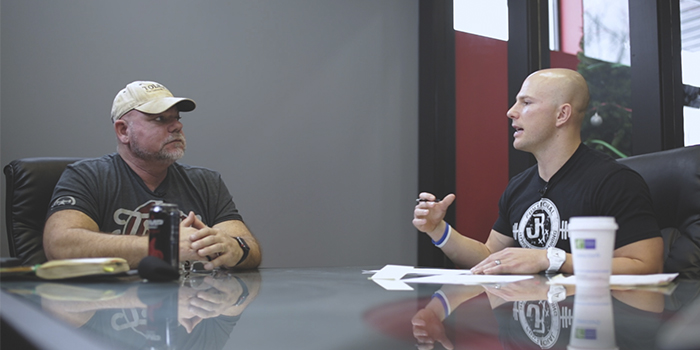
Dave Tate has pushed his body. As a powerlifter, he had to train harder and push further than the lifters around him. The further he pushed, the closer he got to the edge of what his body could handle—and then he often fell over the edge, suffering serious injuries for which he'd find more often find quick-fixes to make it to the next meet than long-term solutions to care for the health of his body. And though Dave may have retired from powerlifting in 2004, his insistence on pushing his body to the absolute limit didn't end there. The result has been daily pain—and lots of it. Dave has worked with numerous experts from nearly every imaginable field to help him with his issues. Some have helped, some haven't, but today Dave still experiences constant pain and movement restriction.
Several weeks ago, Dave decided to contact Dr. John Rusin and has now brought him in to help make some real changes in his life and his training. This video shows their initial conversation, in which Dr. Rusin sets out to collect as much data as he can on Dave and his physical conditions. His goal is to collect data from everyone Dave has worked with, drive it all together to enable objective measurement, and then create a plan to move forward. Dr. Rusin describes it as, "Looking to holistically program what will get Dave to the next level of pain alleviation, longevity, and physical autonomy."
WATCH: Table Talk — Overcoming the Fear of Injury After Rehabilitation
Preparing for this process with Dr. Rusin, Dave knew he needed to be clear about his goal. To illustrate his situation and what brought him to this point, Dave uses a familiar analogy: He has an angel on one shoulder and a devil on the other, but instead of directing him to do good or evil, they tell him to either change his habits or to just push harder in training. The angel tells him to find someone to help navigate the situation he's in with his body, but the devil says, "Fuck it, just keep doing what you're doing." Most of the time, the devil's voice is far stronger.
The main problem for Dave that has led him to this point, above everything else, is pain. The last time he can remember being pain-free was in the '90s. He admits that, at this point, he may not even know what it's like to feel good. This isn't a new problem. Dave's shoulder injury in 2004—which forced him to retire from the sport of powerlifting and still leaves him unable to grab a standard barbell to squat—was the first indication that there were some serious injuries. Things kept piling up: a family history of osteoarthritis, two hip replacements, and countless smaller injuries. Dave has pressed on in spite of all of these issues, but he knows if something doesn't change, he's not going to be able to train anymore. For him, "longevity" just means holding on to the ability to do what he cares about most: training.
With this background as the starting point, this video shows a free-flowing conversation in which Dr. Rusin explores Dave's history of issues, his current physical state, his goals, and many other factors that will come into play as they move forward finding real solutions for Dave's pain and training limitations. To ensure they know what they're dealing with, Dr. Rusin collects data on each of Dave's serious issues and how they have manifested over time, including Dave's 2014 posterolateral left hip replacement, his 2017 anterolateral right hip replacement, and his numerous shoulder surgeries from his time in powerlifting.
He also asks Dave many questions about his training (use of single-leg work, core and anti-rotation exercises, etc.) and his daily life activity (position of his body, time spent standing versus time spent seated, etc.). Dave points out that, even while they're sitting in the office having this very conversation, his right hand is numb and his upper middle back is throbbing with pain—but if he moves forward, his shoulders hurt. There's no way to completely avoid pain, so it's just a matter of settling on which pain is least bothersome at the moment. And going up or downstairs? He has to take them one at a time, shuffling foot after foot onto each stair before venturing to the next one.
With all of the collected data, Dr. Rusin finishes the conversation by outlining the next steps in the process, including a movement screen, a clinical-based assessment, and a movement diagnosis.
By the minute:
- (0:27) The purposes of Dave's conversation with Rusin
- (4:30) "At this point, I may not even know what feeling good feels like"
- (6:22) The effect of incremental change
- (10:15) Dave's hip issues, replacements, and rehab
- (17:55) Surgery is not a guaranteed success
- (18:50) Dave's experience with shoulder surgeries
- (23:46) Chronic groin issues related to Dave's hip
- (30:44) Dave's physical therapy after hip replacement
- (35:46) Dr. Rusin's questions about Dave's training
- (40:50) Knowing when pain is and isn't okay
- (45:07) Dave's daily life restrictions
- (49:45) Bodily positions on a daily basis
- (57:06) First steps in the process of improvement
FIXING DAVE TATE SERIES
- Initial Assessment with Dr. John Rusin
- Movement Screening
- Orthopedic Evaluation
- The Three Areas of Focus Discovered During Initial Evaluation
- Observing Dave's Current Training Capabilities
- Programming the Six-Phase Dynamic Warm-up Sequence
- The Dynamic Warm-Up Sequences for Upper Body and Lower Body
- The 10-Week Update Discussion
- Adjustments to Lower Body Training Days for Phase 3
- Implementing the Lower Body Training Adjustments for Phase 3
- Adjustments to Upper Body Training for Phase 3
- Implementing the Upper Body Training Adjustments for Phase 3










Thanks again for sharing